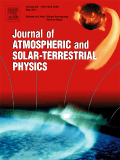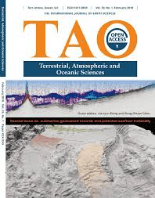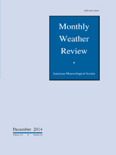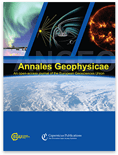
JOURNAL OF ATMOSPHERIC AND SOLAR-TERRESTRIAL PHYSICS
Scope & Guideline
Exploring the Dynamics of Our Atmosphere and Beyond
Introduction
Aims and Scopes
- Atmospheric Dynamics and Weather Patterns:
Research focusing on the analysis and modeling of atmospheric phenomena, including precipitation, storms, and climate variability, utilizing observational data and numerical simulations. - Solar-Terrestrial Interactions:
Investigations into how solar activity, such as solar flares and coronal mass ejections, impacts the Earth's atmosphere and magnetosphere, influencing weather and climate. - Ionospheric Studies:
Exploration of ionospheric behavior, including electron density variations, scintillation, and irregularities, particularly in relation to geomagnetic storms and solar activity. - Remote Sensing and Satellite Observations:
Utilization of satellite data for monitoring atmospheric conditions, including aerosol distributions, cloud properties, and surface radiation measurements. - Machine Learning and Data Analysis:
Application of machine learning techniques to analyze complex atmospheric datasets, enhance predictive models, and derive insights from observational data. - Space Weather Phenomena:
Research on space weather events and their terrestrial impacts, including geomagnetic storms, cosmic ray variations, and their effects on technology and human activities. - Climate Change and Variability:
Studies addressing the implications of climate change on atmospheric processes, including long-term trends, extreme weather events, and regional impacts.
Trending and Emerging
- Machine Learning Applications:
There is a growing trend in employing machine learning techniques for atmospheric predictions, data assimilation, and analysis of complex datasets, indicating a shift towards more sophisticated analytical methods. - Impact of Climate Change on Extreme Weather:
Research focusing on the relationship between climate change and extreme weather events is increasingly prominent, reflecting global concerns about climate resilience and adaptation. - Interdisciplinary Approaches to Atmospheric Studies:
Emerging themes highlight interdisciplinary studies that integrate atmospheric science with fields such as geology, space weather, and environmental science, showing a trend towards holistic understanding. - Satellite Remote Sensing Innovations:
Advancements in satellite technologies and methodologies for atmospheric monitoring are becoming a significant focus, enhancing the capacity to observe and analyze atmospheric phenomena. - Space Weather and Technological Impacts:
The exploration of space weather phenomena and their implications for technology, particularly in communication and navigation systems, is increasingly relevant in the current research landscape.
Declining or Waning
- Localized Atmospheric Phenomena Studies:
Research addressing localized atmospheric events, such as specific thunderstorm or fog case studies, appears to be less frequent compared to broader studies involving regional or global phenomena. - Traditional Climate Modeling Approaches:
There is a noticeable decline in the use of conventional climate models without integration of advanced machine learning techniques or data assimilation methods, as the field shifts towards more innovative approaches. - Historical Solar Activity Analysis:
Research focusing on historical solar cycles and their effects on the Earth’s atmosphere has decreased, likely due to a shift towards immediate and predictive studies. - Basic Observational Studies:
Basic observational studies without significant data analysis or modeling components are less common, as the journal gravitates towards more complex, data-driven research.
Similar Journals

Atmospheric Science Letters
Advancing knowledge in atmospheric science.Atmospheric Science Letters, published by WILEY, is a leading open-access journal in the field of Atmospheric Science. Since its establishment in 2000, it has significantly contributed to advancing knowledge related to the Earth's atmosphere, focusing on both theoretical and practical aspects. With an impressive Q2 ranking in the Atmosphere Science category as of 2023 and a Scopus rank of 62 out of 148, this journal provides a platform for researchers and professionals to share their findings and insights. The journal’s commitment to open access since 2016 ensures that cutting-edge research is accessible to a global audience, fostering collaboration and innovation in the atmospheric sciences. Addressed from its headquarters at 111 River St, Hoboken, NJ, USA, Atmospheric Science Letters is pivotal for students, researchers, and professionals seeking to stay abreast of the latest developments in this dynamic field.

METEOROLOGY AND ATMOSPHERIC PHYSICS
Unveiling the Secrets of Our AtmosphereMETEOROLOGY AND ATMOSPHERIC PHYSICS is a premier journal published by SPRINGER WIEN, dedicated to advancing the study of atmospheric phenomena and weather-related sciences. With an ISSN of 0177-7971 and an E-ISSN of 1436-5065, the journal has established itself as an important contributor in the field, particularly noted for its contributions in atmospheric science, holding a Q3 ranking in the 2023 category quartiles. Covering a wide array of topics from meteorological modeling to the physics of the atmosphere, it serves researchers, professionals, and students alike, facilitating the dissemination of significant findings and innovative research. The journal’s acceptance of articles until 2024 encourages a continuous influx of knowledge, and despite its lack of Open Access, it plays a crucial role in enriching the academic landscape for those engaged in Earth and planetary sciences, holding a commendable rank of 78 out of 148 in Scopus. Located in the scenic city of Vienna, Austria, the journal is positioned to harness the vibrancy of the academic community, providing a platform for valuable insights that can drive forward the field of meteorology and atmospheric physics.

Tethys-Journal of Mediterranean Meteorology & Climatology
Bridging Research and Climate Solutions in the MediterraneanTethys - Journal of Mediterranean Meteorology & Climatology, published by the Associació Catalana de Meteorologia (ACAM), serves as a specialized platform dedicated to advancing the study of meteorological and climatological phenomena within the Mediterranean region. With a Scopus Rank of #94 out of 148 in the field of Atmospheric Science, this journal is positioned in the Q4 category, reflecting a growing recognition among researchers focused on regional climate variations and environmental challenges. Established in 2012 and publishing through 2023, Tethys aims to provide open access to high-quality research articles that address critical issues impacting climate and weather patterns, thus contributing to a deeper understanding of Mediterranean meteorology. The journal’s mission aligns closely with the increasing global emphasis on climate studies and serves as an essential resource for academics, practitioners, and students dedicated to sustainably addressing the environmental and climatic challenges faced by this diverse and dynamic region.

TERRESTRIAL ATMOSPHERIC AND OCEANIC SCIENCES
Innovating Research for a Sustainable PlanetTERRESTRIAL ATMOSPHERIC AND OCEANIC SCIENCES, published by SpringerNature, is a distinguished peer-reviewed journal that has been an essential platform for innovative research in the fields of atmospheric science, oceanography, and Earth and planetary sciences since its inception. With an Open Access policy established in 1990, the journal ensures wide dissemination of knowledge, allowing researchers, professionals, and students to access cutting-edge findings without restrictions. Based in Switzerland and featuring a comprehensive coverage from 1996 to 2024, the journal currently holds a Q3 ranking across various categories, indicating its growing significance in the scientific community. Although it is positioned within the 39th percentile in Earth and Planetary Sciences, its commitment to fostering high-quality research makes it a valuable resource for advancing understanding of terrestrial environments and their interconnections. Researchers seeking a platform for their work in atmospheric and oceanic sciences will find TERRESTRIAL ATMOSPHERIC AND OCEANIC SCIENCES to be an ideal venue for sharing their insights with a global audience.

JOURNAL OF CLIMATE
Transforming Insights into Action on Climate ChangeThe JOURNAL OF CLIMATE, published by the American Meteorological Society, stands as a premier source of cutting-edge research in the field of atmospheric science. With an impressive impact factor reflecting its rigorous peer-review process, this journal ranks in the top 20 of its category according to Scopus, with a remarkable percentile of 88th. Since its inception in 1988, the JOURNAL OF CLIMATE has been a vital platform for disseminating high-quality studies that deepen our understanding of climate systems and their global implications. It serves a diverse audience of researchers, professionals, and students interested in climate variability, climate change, and the dynamics of atmospheric processes. Though not an open-access journal, it offers wide accessibility through numerous academic repositories. As it continues to publish essential findings up to 2024, this journal plays a crucial role in advancing knowledge and fostering dialogue within the atmospheric science community.

MONTHLY WEATHER REVIEW
Advancing the Frontiers of Atmospheric ScienceMONTHLY WEATHER REVIEW, published by the American Meteorological Society, is a leading journal in the field of atmospheric science, recognized for its rigorous peer-reviewed articles that contribute significantly to the understanding of weather patterns and climate systems. With an impressive Q1 ranking in the 2023 category quartiles and a strong standing (#41 out of 148) in the Earth and Planetary Sciences Scopus rankings, the journal serves as an essential resource for researchers, professionals, and students alike. Although it does not currently offer open access, its comprehensive coverage of meteorological research spanning from 1960 to 2024 makes it invaluable for those seeking to stay at the forefront of developments in weather analysis and prediction. Situated in Boston, Massachusetts, this journal not only showcases pioneering research but also emphasizes the importance of collaborative efforts in the meteorological community, ultimately contributing to advancements in our understanding of atmospheric phenomena.

ADVANCES IN ATMOSPHERIC SCIENCES
Advancing Knowledge for a Sustainable EnvironmentADVANCES IN ATMOSPHERIC SCIENCES is a highly esteemed journal published by SCIENCE PRESS, dedicated to advancing the field of atmospheric sciences. With an impressive impact factor and ranking as Q1 in Atmospheric Science as of 2023, this journal serves as a leading platform for researchers, professionals, and students to disseminate substantial findings and innovative methodologies across various topics within the atmospheric sciences domain. Established in 1984 and continuously publishing through to 2024, it has successfully positioned itself among the top ranks, currently standing at #17 out of 148 in the Scopus category, highlighting its significance in the field with a remarkable 88th percentile. Although it operates under traditional access, the journal provides invaluable insights into climate dynamics, meteorology, and environmental processes that are crucial for both academic and practical applications. Based in Beijing, China, ADVANCES IN ATMOSPHERIC SCIENCES is committed to fostering a global dialogue and collaboration among scholars and industry experts, making it an essential resource for those invested in understanding and addressing contemporary atmospheric challenges.

ANNALES GEOPHYSICAE
Pioneering Insights into Earth and Planetary SciencesANNALES GEOPHYSICAE is a distinguished open access journal published by COPERNICUS GESELLSCHAFT MBH, renowned for its contributions to the field of geophysics and related disciplines. Since its inception in 1996 as an open access journal, ANNALES GEOPHYSICAE has provided a vital platform for researchers to disseminate their findings covering a wide array of topics within Astronomy and Astrophysics, Atmospheric Science, and Earth and Planetary Sciences. The journal enjoys a commendable reputation, evidenced by its impressive 2023 category quartiles, ranking Q1 in Earth and Planetary Sciences (miscellaneous) and Q2 in several other relevant categories, reflecting its significance in the global research community. Based in Germany and accessible to a diverse audience, ANNALES GEOPHYSICAE serves as an essential resource for academics, practitioners, and students alike, striving to foster advancements in our understanding of geophysical phenomena and encouraging collaboration across disciplines.

Weather
Charting New Paths in Climate ResearchWeather is a prestigious academic journal published by WILEY, specializing in the field of Atmospheric Science. Since its inception in 1946, the journal has emerged as a key resource for researchers, professionals, and students seeking to deepen their understanding of meteorological phenomena and climate dynamics. Weather is recognized for its robust impact within the scientific community, boasting a 2023 Scopus ranking of 96 out of 148 in the Earth and Planetary Sciences category, placing it comfortably within the Q2 category. Although it does not offer open access options, the journal is committed to publishing high-quality, peer-reviewed articles that advance the knowledge base of atmospheric sciences up to 2024. Through its diverse range of research, reviews, and case studies, Weather continues to play a vital role in facilitating discussions and discoveries in this essential field of study.

Idojaras
Cultivating a deeper understanding of our changing atmosphere.Idojaras, a prominent journal published by the Hungarian Meteorological Service, has been a vital contributor to the field of Atmospheric Science since its inception in 1980. With a specific focus on the intricacies of weather phenomena, climate variability, and environmental change, this journal serves as a platform for researchers and professionals to disseminate their findings. Although currently categorized in Q4 of Atmospheric Science with a Scopus rank of #122 out of 148, Idojaras is dedicated to improving its impact and visibility through rigorous peer-reviewed research and comprehensive analyses that engage a global audience. This scholarly publication, which operates without open access, is pivotal for advancing knowledge in meteorological studies, thereby appealing not only to seasoned scientists but also to students and scholars eager to explore this dynamic field. Located in Budapest, Hungary, the journal continues to strive for excellence in its coverage through the convergence of past and present meteorological research, making it a significant resource for anyone interested in the atmospheric sciences.